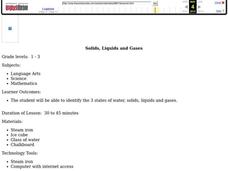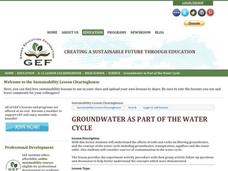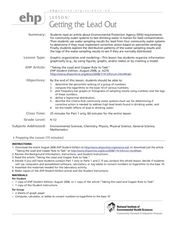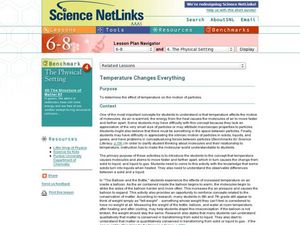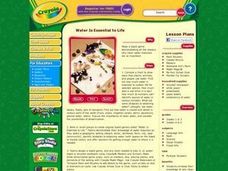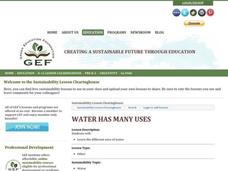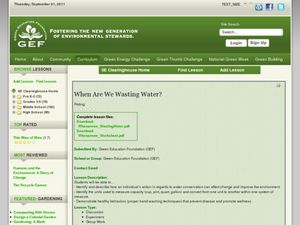Curated OER
Reading the River
In collaborative groups, young ecologists measure the temperature, pH, and dissolved oxygen for three different freshwater samples. They examine each sample with a microscope and record observations on the microorganisms in the pond...
Curated OER
Physical Changes and States of Matter
Fourth graders identify a physical change as one that results in a change in size, shape, or state of matter. After an initial teacher-led discussion and demonstration, groups of students get together to perform an experiment which...
Curated OER
Creating Energy From Water
Students study water and its energy. In this water energy lesson, students discuss hydroelectricity and make models of water turbines.
Curated OER
Solids, Liquids and Gases
Students explore solids, liquids, and gases. In this states of water lesson plan, students conduct a scientific investigation that requires them to observe and note the differences among solid, liquids, and gases.
Curated OER
Groundwater as Part of the Water Cycle
Make sure to read through the activity procedures thoroughly before teaching this instructional activity because the materials list is incomplete. Also, the mentioned worksheets and booklet are not available. However, there is no need to...
Curated OER
The Work of Waves and Wind
This is not revolutionary, but it is informative. Earth science viewers in grades 7-12 get carried away with wave and wind erosion. They view diagrams of how waves impact ocean shorelines. They see examples of the different types of sand...
Curated OER
What Floats Your Boat?
This open-ended boat building exercise is meant to be part of a three-lesson series on ships. Links to the other two lessons are included. This particular part is mostly a group lab activity in which they build a boat, find its load line...
Curated OER
Getting the Lead Out
The article for this instructional activity no longer accessible through the links in the lesson plan, but can be found in the National Center for Biotechnology Information website. After reading it, environmental science students answer...
Curated OER
Three is a Toxic Number
Future public health advocates read a case study of a combination of water pollutants that may be linked to autism. The class is split into three groups, one to research each of the suspected chemicals. The look at how each one affects...
Curated OER
Temperature Changes Everything
Middle school chemists visit interactive websites in order to discover what happens to molecular motion when heat is added to matter. They conduct an experiment that demonstrates the expansion of matter with the addition of heat. A lab...
Curated OER
Putting the Ice in Hockey
Eighth grade physical science classes examine why the ice on which hockey is played is slippery. They do so by discussing phases of matter and the molecular motion in each. They read an article on a website and write out answers to 10...
Curated OER
Environmental Concerns (1) Analysis of Lead in Paint (2) Analysis of Water
A scenario and background information are provided for two different open-ended experiments that experienced chemistry classes can perform toward the end of the school year. In the first, they design a method for testing flakes of paint...
Curated OER
Who Owns Water
Students role play how water is allocated to different holders of water rights. In this ecology lesson, students identify the different water rights available. They explore problems associated with water use including drought, degraded...
Curated OER
Decision Making a Mock Town Meeting on a Proposed Tank Farm
Young scholars identify the potential hazards to the water supply. In this ecology lesson, students role play a town hall meeting to discuss the proposal of a storage tank construction in their place. They present their arguments and...
Curated OER
Seepy Sandwich
Students explore Earth science by participating in a pollution activity. In this water infiltration lesson plan, students utilize a water sprayer, food coloring and slices of bread to simulate how pollution can spread into our drinking...
Curated OER
Why Is Water Important?
Students conceptualize and communicate ideas about the many varied and important uses of water. They create original art reflecting their ideas. Students write and read orally a sentence describing their illustration.
Curated OER
Why Live Near Water?
Students explore why communities settle in locations where land and water meet. They create three-dimensional models to demonstrate their understanding of the numerous needs water serves. They then analyze the importance of water to...
Curated OER
Watershed Ways
Students connect the water cycle concept with local fresh water availability and consumption. They identify waterways in their own region. Students define, predict, research, and map local watershed areas. They research the positive...
Curated OER
Water is Essential to Life
Students increase their knowledge of why clean water resources are essential to the survival of plants, animals, and people. They deomonstrate their understanding of the role of water for sustaining life by creating an original board game.
Curated OER
Strong Ice
Through three activities, first-time physical scientists wonder at the properties of water. Freeze some soda cans and a container of water prior to the investigation to show that water expands when frozen. Lab groups experiement with...
Curated OER
Water Has Many Uses
Students discover numerous uses of water. In this water usage lesson, students interview family members and discover unknown ways water is used in our daily lives. Numerous resources are provided.
Curated OER
Seepy Sandwich
Students study how water infiltration can carry pollution underground. In this water infiltration lesson, students conduct an experiment on water infiltration and underground pollution.
Curated OER
When Are We Wasting Water
Students study water conservation. In this water conservation instructional activity, students participate in a water conservation experiment. Students discover how to conserve water while washing their hands.
Curated OER
Let Me Tell You About...
Students comprehend the differences between flat maps and relief or topographical maps. They recognize how forces such as earthquakes, volcanoes, water, and wind-as well as human actions--have altered the Earth's surface. Students work...





